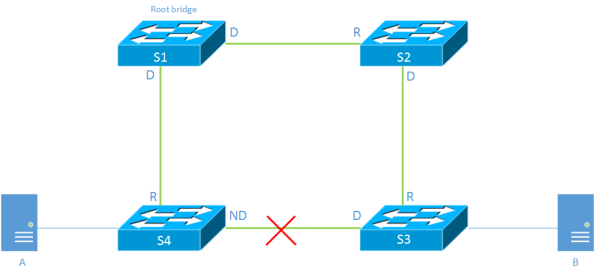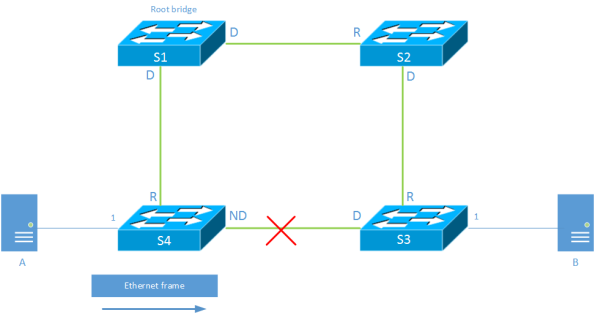Ethernet, STP, Topology change and the behaviour of Ethernet
Introduction
This post is inspired by a post at IEOC about Uplinkfast and TCN which
can be found here.
Before we get to those parts, let’s recap how Ethernet and STP work together.
Spanning Tree
The Spanning Tree Algorithm builds a loop free tree by comparing Bridge ID(BID) and
least cost paths to the root bridge. By doing this it blocks all links not leading
to the root.
MAC Learning
Switches learn where to forward frames by looking at the source MAC address of the frame
on the port that the frame was received on. This learning is done in the data plane
as opposed to routing where the routes are learned in control plane. I will come back
to this later in the post.
S4 learns that A is located on port 1 after A has sent a frame. This is stored in
the MAC address table located in Content Addressable Memory (CAM). The CAM is a
fast memory optimized for quick lookups in the table. By default there is a 300
second aging timeout for learned MAC addressesm, meaning that if the switch
does not see any traffic from a source MAC within five minutes the entry will
Continue reading
Cisco now #1 on bladeservers in US with the Cisco UCS
Five years ago, Cisco started out on their journey to get in on the server market.
Very few people believed that Cisco would get a big share of the market.
Today, just five years later we are reached by the news that Cisco is now
the largest seller of blade servers in the US! From nothing to #1 in five
years, that is an impressive feat for sure!
This slide provides a summary of some of the statistics for UCS:
Over 33000 customers are now using UCS and it’s growing! Cisco is still showing
significant growth at 39% The only other vendors to show growth are Dell and Hitachi.
Cisco now has 40.9% of the blade server market in the US. Worldwide, Cisco is at #2
behind HP. I’m expecting this gap to decrease and I wouldn’t be surprised if Cisco
passes HP globally within a year or two as well.
The next slide is very interesting. Cisco went from nothing to #1 in five years.
IBM used to be a major player but now only has 10% of the market.
Not only has UCS been selling really well, it also has a lot of performance records.
Currently UCS Continue reading
A Short Update on CML from #CLUS
Hey everyone,
I’ve been having a really good time here at Cisco Live US. Here is a short update on CML.
General Info
CML is being released end of June or beginning of July. The corporate edition with
a base license and support for up to 15 nodes will be listed at around 13000$ per year.
If you subscribe for two years, the discount is 5% and for three years it is 10%
Normally 15 nodes cost around 13000$ per year so basically you get 5 nodes for “free”
if you get the base package which has the SKU R-CML-CE-K9=.
IOS will be supported by running IOSv. Every IOSv image requires around 512 MB of memory.
System Requirements:
- The Cisco Modeling Labs server runs on VMware ESXi 5.0, 5.1, and 5.5.
- Recommended – Cisco UCS®
- C220 M3 Rack Server with 16 core CPU and 128 GB memory or Cisco UCS
- C460 M2 High-Performance Rack Server or higher model (actual memory and CPU consumption depends
on the number of virtual nodes and virtual network OS types). To help determine the appropriate memory
please find the Cisco Modeling Labs Calculator at http://www.cisco.com/go/cml. - Following are the minimum hardware Continue reading




